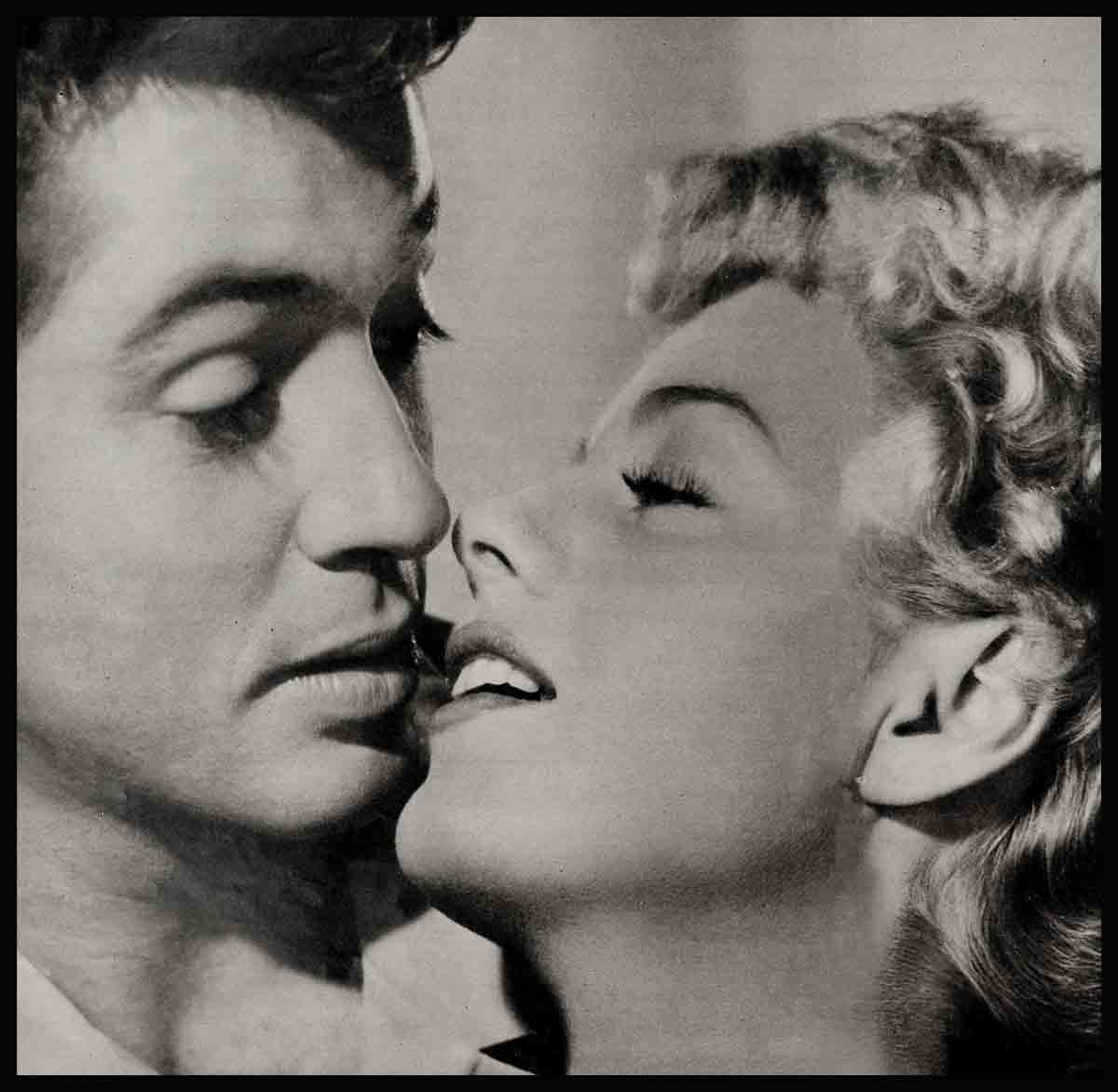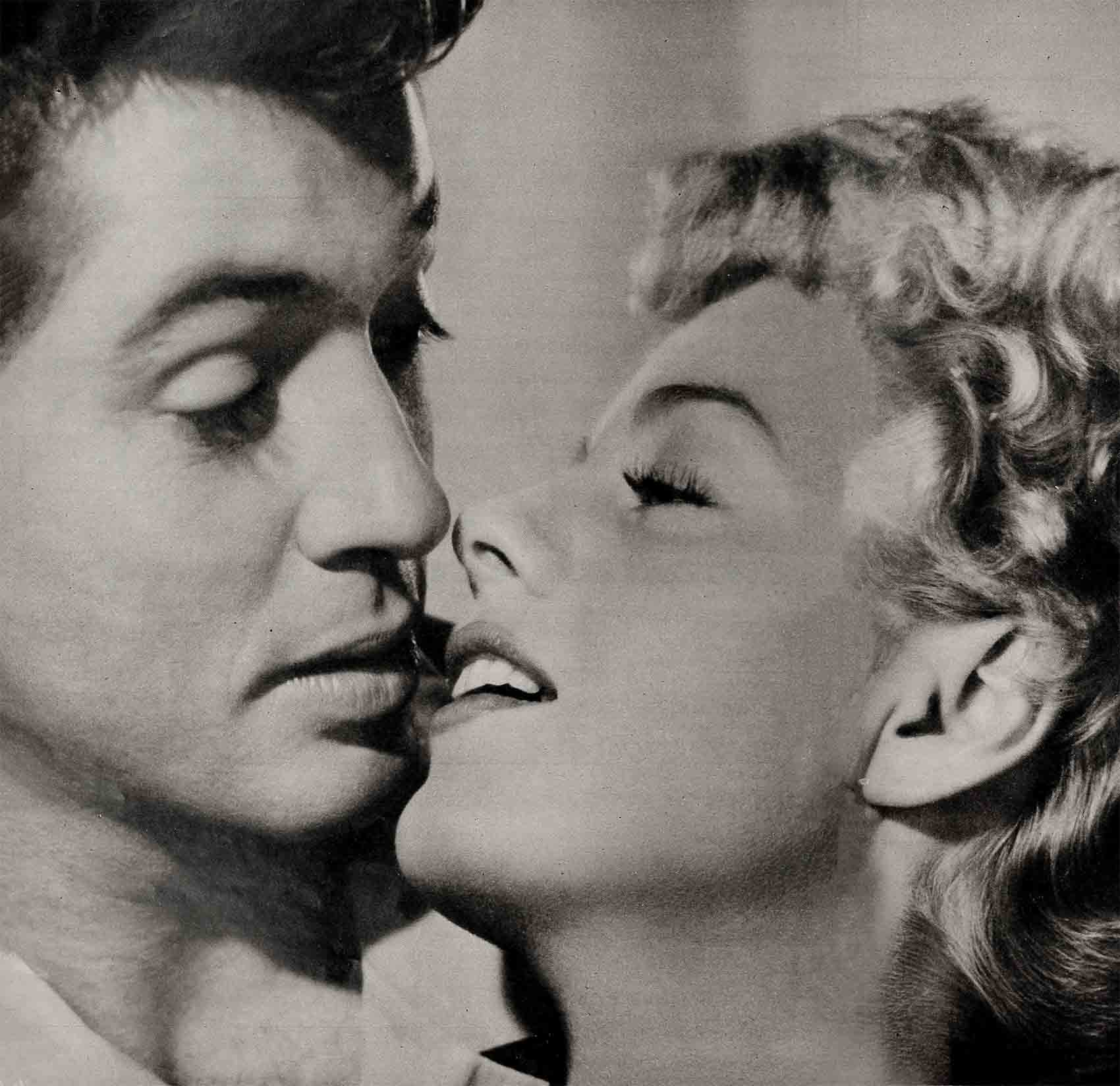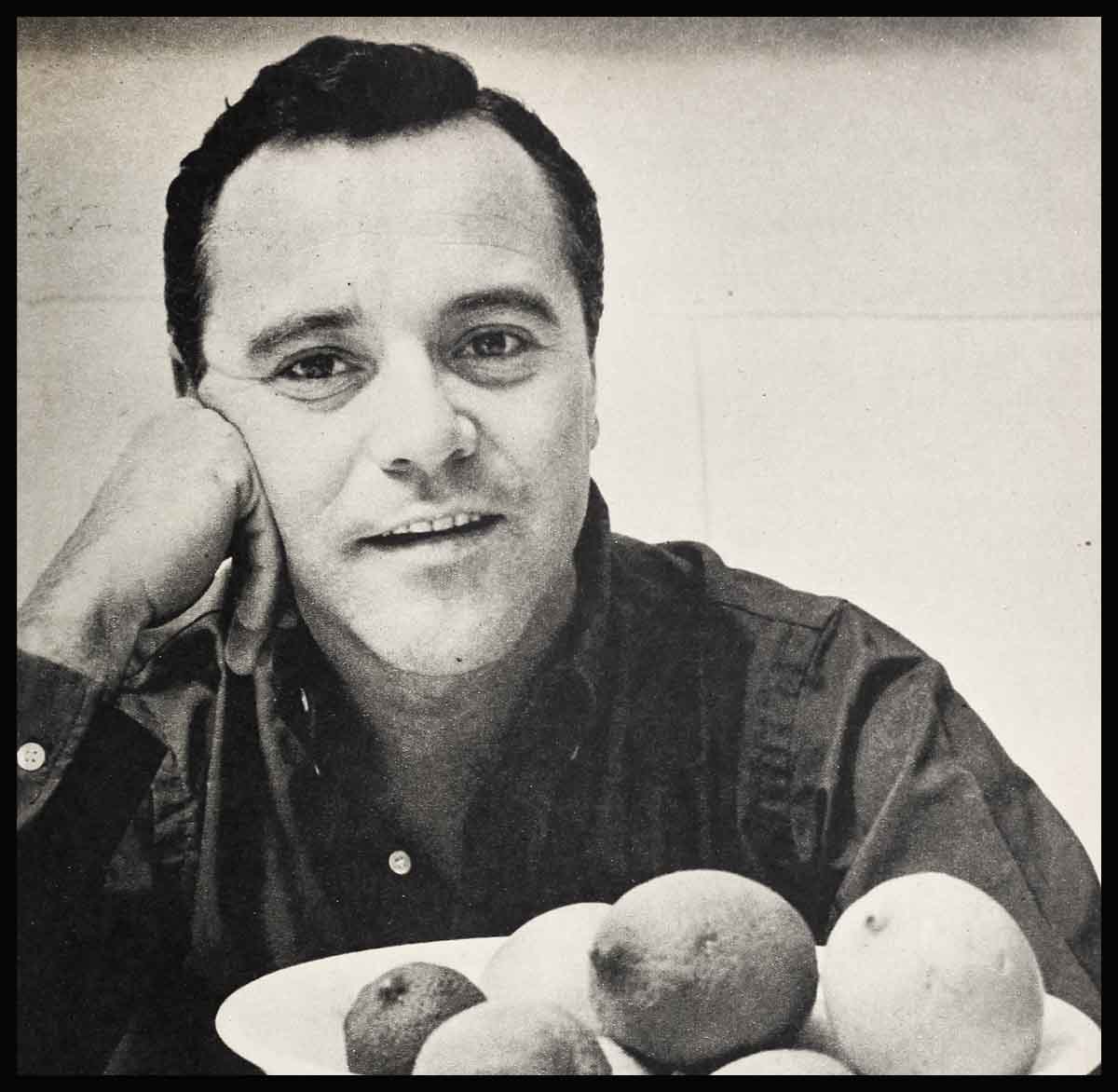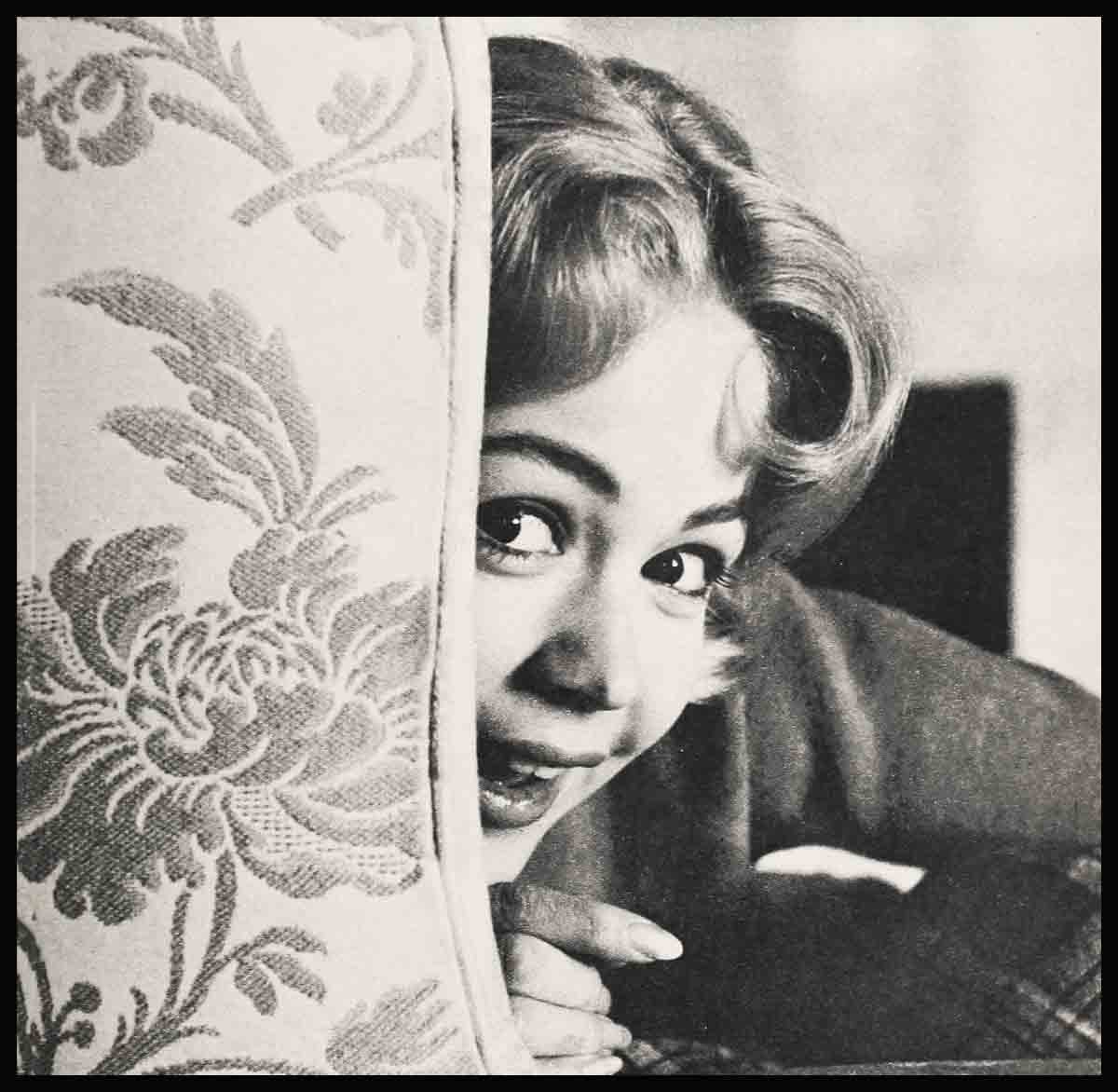
They Made Fun Of Love—Shelley Winters & Farley Granger
Shelley Winters and Farley Granger stood side by side on a huge sound stage at RKO, surrounded by the cast and crew of Behave Yourself, and cut a huge cake. It was their party, given by the studio to announce their engagement. Photographers were called in, and they took hundreds of pictures of the stars, the cake, the other actors, and of the ring Farley had given Shelley a short time before. At long last the engagement everyone had been expecting was practically admitted. It was a great day for love.
A day or so later the lovers skipped down the steps of an airliner in New York and were met by a crowd of reporters. The flash bulbs popped and then the reporters moved in.
“What about this engagement?” one reporter asked. “When are you getting married?”
“Who, us?” said Farley or Shelley. “We’re just good friends.”
“But what about the ring?” queried a newspaperman. He pointed to the circle on Shelley’s finger.
“A friendship ring,” said Shelley. “Like I said—we’re really just good friends.”
To the cynics and, unhappily. to many fans it seemed like an old story. It seemed like a publicity romance, a device which uses young love to ensnare the trusting fans, to lure them to the side of a pair of stars.
The publicity romance has long been defended by movie salesmen on the grounds that throughout literary history, people have desired to escape their own sterile existences by reading of the loves of the heroes and heroines of mythology and actuality. This is true. Love stories have always been popular. But think of the kickback if almost any of the classic love tales had been proven a fake. If Edward, King of England, had made his historic renunciation of the throne for his love of Wallis Simpson—and a few days later when asked about it by a London Louella Parsons had said, “Who, me—and her?” he might well have been stoned by the true lovers of the world.
Someday when the photographers have left and the newspaper boys are home in bed, Shelley may look at Farley and see the dashing qualities in him that she has looked for in a man for so long. And he may look at her and see the woman he has been wanting for his wife. Then they both may realize that life is short and they may look for love in vain, away from each other. It may be then that they will try to make it a real love. And everything will turn out all right. But shortly before their engagement announcement, they were guests on the show of a prominent radio reporter and the conversation went something like this:
REPORTER: “Well, I understand you two kids are in love.”
SHELLEY: “It sort of looks like it, doesn’t it?”
REPORTER: “Is that an engagement ring you’re wearing, Shelley?”
SHELLEY: “It does look like one. Is it Farley?”
FARLEY: “That is for the lady to say . . .”
REPORTER: “Now come clean, you two, are you going to get married?”
SHELLEY: “Everybody keeps asking us that . . .”
REPORTER: “Well, why don’t you answer them?”
FARLEY: “We might do that one of these days.”
REPORTER: “Well, will you deny you are engaged?”
SHELLEY & FARLEY: “That wouldn’t be fair, now, would it?”
It seemed then that Shelley and Farley were making fun of love. But maybe they were just having fun, because not long after that, Louella Parsons wrote that they were planning to marry in Paris.
It is true that the romance between Farley and Shelley has been one of long standing, It began more than three years ago, shortly after Shelley became a smash hit at Universal. They met, and almost instantly became fast friends.
When their names were linked in the columns, press agents decided it was a natural. Instead of planting a story that the two had had a pleasant date, they began feeding the columnists lines like: “Shelley Winters and Farley Granger held hands all during the first show at Mocambo.” And a romance was born.

A year or so ago, when Farley returned from a tour of Europe, the columnists thought he was staying an awfully long time in New York for a fellow with a sweetheart in California whom he hadn’t seen in a few months. They said so. Soon the word was out that Shelley was packing to go to Farley’s arms. A bit later, she’d bought the tickets. Then-she was on her way to the airport. It was dramatic and in sequence, except for one thing, Shelley was making no such moves. She was living a normal routine right where she was.
“When are you going to see Farley?” someone asked her.
“When is he coming to see me?” Shelley is reported to have replied. “It’s the same distance both ways, isn’t it?”
This gave the cynics plenty of material to work with—because, after all, did that sound like the beginning of true love?
It would be a sad thing, indeed, if the romance between them were phony, for despite all you hear about them, Shelley and Farley are the loneliest kids in Hollywood. You will find proof of this buried in the scores of magazine stories written about them in the last couple of years. Farley, for instance, told a magazine writer not many months ago that he was going to live either in New York or abroad, and return to Hollywood only when he was needed for a picture. He gave as his reason that he had never found real happiness or contentment there. And Shelley Winters has wept publicly on the lapels of writers and others because the man of her dreams has not yet come along to claim her.
It is the considered opinion of those who know Shelley best that she is not only in love with Farley Granger, but downright predatory in her search for a legitimate romance. She wants true love so badly that she spends a good deal of her time when not being photographed with Farley, seeking it out. One of the first things she usually says upon arriving at a party is: “Where are all the single men?” And a standard Winters crack at lunch in the Universal commissary is: “Who’s the guy over there in the corner? Is he a bachelor?”
Shelley Winters’ genuine crushes have not been nearly as highly publicized as her present one, mainly because they have been directed at men who have not been big names. There have been a number of them since she met Farley, the most important to her probably being Liam O’Brien, Edmund’s brother, and one of the handsomest lads in Hollywood.
Farley, on the other hand, with the possible exception of Shelley, has apparently not been severely smitten to date. Being one of the most dashing of the young blades around Hollywood, he has naturally had lots of dates, but he has yet to be poleaxed by passion for a doll.
Shelley and Farley’s fans run into the millions. Many of them are fanatically in support of these youngsters. But in the main, they will be hurt if the bubble that is being blown up now bursts and proves that the whole thing was a sham.
People on the inside can tell you now that the situation is wearing on those concerned. Farley was at a night spot recently with Shelley, and he sat for hours glumly watching the dancers, not speaking. Somebody asked him if he was having a good time. He said he guessed he was. Shelley, across from him, seemed anxious to be someplace else. Presently, a couple of columnists walked in and sat at nearby tables. It might have been coincidence, but Farley and Shelley leaped to the dance floor—and for an hour or so seemed to be the gayest, most carefree couple in the place. Maybe they were—and again maybe they were just playing the game.
The majority of movie fans are in the impressionable age group, youngsters who believe what they are told by older people. If they are told that Farley Granger is going to appear in a certain movie, and he doesn’t appear, it is not terribly important, although a breach of truth. If they are told that Shelley Winters has 12 mink coats in her closet, and she only has one, that, too, is not so bad. But when it comes to love, there is a sincerity in the teen-ager that mustn’t be toyed with. If these fans are told that their idols adore one another and in a week or so they find the idols in love with others, it destroys a bit of faith in a very precious thing. It isn’t fair—and it isn’t necessary. There are other ways to build popularity.
A number of years ago, a magazine editor had this proved to him the hard way. Romances were scarce in Hollywood at the time. It just seemed that nobody was falling in love. The editor decided to grow one of his romances, figuring it would have the added feature of being exclusive with his magazine. Working through the right connections, he arranged to have Lana Turner, then a newcomer to pictures, and Victor Mature pose in lovey-dovey attitudes for his cameramen. He sent off the pictures and, after it was too late for the opposition magazines to cut in on his romance, he had stories planted in the papers about the big Turner-Mature romance.
The boy and girl were doing as they were told, for they were not stars then. They went out together, called each other pet names in public and so on. Things were going great, it seemed, until one day, just 24 hours before the editor’s magazine appeared on the newsstands, Lana grew tired of the whole business, and took off. She flew up to San Francisco to see the man she was really interested in—and the next day papers all over the nation carried the headlines: LANA TURNER TO WED TONY MARTIN.
She didn’t marry him, it turned out, but the editor didn’t sell many magazines that month, either. And if you were to ask Lana today, she would tell you it was probably one of the most foolish things she has ever done. She may have gotten her name linked in print with a good many men in later years, but you can bet your shirt they were all genuine pulse-racers.
Farley Granger certainly has no need for phony publicity to further his career. His ability as an actor is more evident in each picture he makes. He has the respect of the kids and the grown ups because of his work and his talent. He is, in private life, young America personified, handsome, virile, and chock full of the joy of living. If he were none of these things, but an untried, ambitious fledgling then it might make sense to try any device just to popularize his name and possibilities as a lover.
Shelley Winters is also a star, established ad properly renowned. There is no doubt t she is one of the best actresses in Hollywood. Her latest picture, A Place In the Sun, proves that. She is such a character in so many respects that all she has to do is appear someplace, or open her mouth and say something and it gets in the columns. A combination of extreme ability and color in private and public life is enough for any star. Shelley Winters doesn’t need a put-up romance to further her career or earn her new fans.
An accurate check of the past activities of the biggest stars today, the ones who have lasted the longest, that is, discloses that very few of them ever went for the phony romance gag. Those who were forced to, abandoned it for better things after a very short time. That goes for the old steady types and the glamor category.
The word glamor may be the key of the whole situation, It seems to be accepted that, to have glamor, a man or woman must live like a single rooster in a yard full of hens—or vice-versa. That just isn’t true. Glamor, actually, has little to do with romance, and practically nothing to do with real love.
When Farley Granger and Shelley Winters were in New York a few months ago, just after their engagement party, they appeared together in public quite a number of times. But they were by no means together all of the time. Away from the gay spots where the press gang hang out, they found old cronies of their very own and renewed old friendships.
There was no rush to buy a trousseau, or to set a wedding date. There may have been many legitimate reasons for this that have nothing to do with a phony romance. Certainly, Farley and Shelley are genuinely fond of one another and, as has been said, they are in the market for marriage.
If they make a monkey out of love, they may hurt themselves by losing the faith of the fans who believe in them. But if they do marry, the unpleasant charges that they’re playing up the romance for what it’s worth in publicity will die an immediate and just death.
THE END
—BY STEVE CRONIN
It is a quote. MODERN SCREEN MAGAZINE SEPTEMBER 1951





No Comments